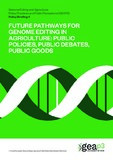| dc.contributor.author | Glover, Dominic | |
| dc.contributor.author | Friedrich, Beate | |
| dc.contributor.author | Ely, Adrian | |
| dc.contributor.author | Noland, Angela | |
| dc.contributor.author | Lidstone, Alexandra | |
| dc.date.accessioned | 2021-03-19T12:00:06Z | |
| dc.date.available | 2021-03-19T12:00:06Z | |
| dc.date.issued | 2021-03 | |
| dc.identifier.uri | https://opendocs.ids.ac.uk/opendocs/handle/20.500.12413/16485 | |
| dc.description.abstract | Genome editing belongs to a category of cutting-edge modern technologies that have assumed a totemic importance for some politicians and policy advisors as, urged on by futurologists and business executives, they contemplate the emerging disruptions of the ‘Fourth Industrial Revolution’ (4IR). Other technologies that have been associated with 4IR include nanotechnology, big data and machine-learning, self-driving vehicles, stem-cell therapies and laboratory-cultured artificial meat.
Genome editing is a technique of genetic engineering that involves the alteration of an organism’s genetic structure by adding, deleting, changing or replacing individual nucleotides or sequences of DNA. Also known as gene editing, it comprises several different methods and tools, which can be used to alter the traits of crop plants and livestock animals (see GEAP3 Briefing 1).
The truth is that nobody really knows how technologies like these might change industries, economies and societies in the coming decades, but everyone seems to agree that emerging technologies will have – or are already having – a transformational impact. So how should societies be preparing themselves to engage with genome editing and its products in the domains of food and agriculture, including all the possible opportunities, risks, advantages and costs which they present?
This briefing collates key insights arising from desk-based research and an expert dialogue which was convened during October 2020 by the policy hub of the GEAP3 network,
to discuss the governance of genome editing applications in agriculture, especially in crop breeding. The dialogue events focused on policy and regulatory questions for the European Union (EU) and the United Kingdom (UK) in the context of their trade relationships with each other and with third countries, especially in North America and sub-Saharan Africa.
This briefing identifies the major themes arising from the dialogue and documentary sources, and sets out a number of outstanding questions for policy. | en |
| dc.language.iso | en | en |
| dc.publisher | Genome Editing and Agriculture: Policy, Practices and Public Perceptions (GEAP3) Network | en |
| dc.relation.ispartofseries | Genome Editing and Agriculture: Policy, Practices and Public Perceptions (GEAP3) Policy Briefings;4 | |
| dc.rights.uri | http://creativecommons.org/licenses/by/4.0/ | en |
| dc.subject | Agriculture | en |
| dc.subject | Science and Society | en |
| dc.subject | Technology | en |
| dc.title | Genome Editing and Agriculture: Policy, Practices and Public Perceptions (GEAP3) Policy Briefing 4: Future Pathways for Genome Editing in Agriculture: Public Policies, Public Debates, Public Goods | en |
| dc.type | Series paper (non-IDS) | en |
| dc.rights.holder | Genome Editing and Agriculture: Policy, Practices and Public Perceptions (GEAP3) Network | en |
| dc.identifier.externaluri | https://static1.squarespace.com/static/5e3b0359c69d975ce0139329/t/604136a335290c2ba051c42b/1614886564047/GEAP3_Policy_Briefing_4.pdf | en |
| dc.identifier.team | Rural Futures | en |
| rioxxterms.funder | Default funder | en |
| rioxxterms.identifier.project | Genome Editing and Agriculture: Policy, Practices and Public Perceptions (GEAP3) | en |
| rioxxterms.version | VoR | en |
| rioxxterms.funder.project | 7f7ff39c-170d-4988-9a25-d2bb8d6ef910 | en |


